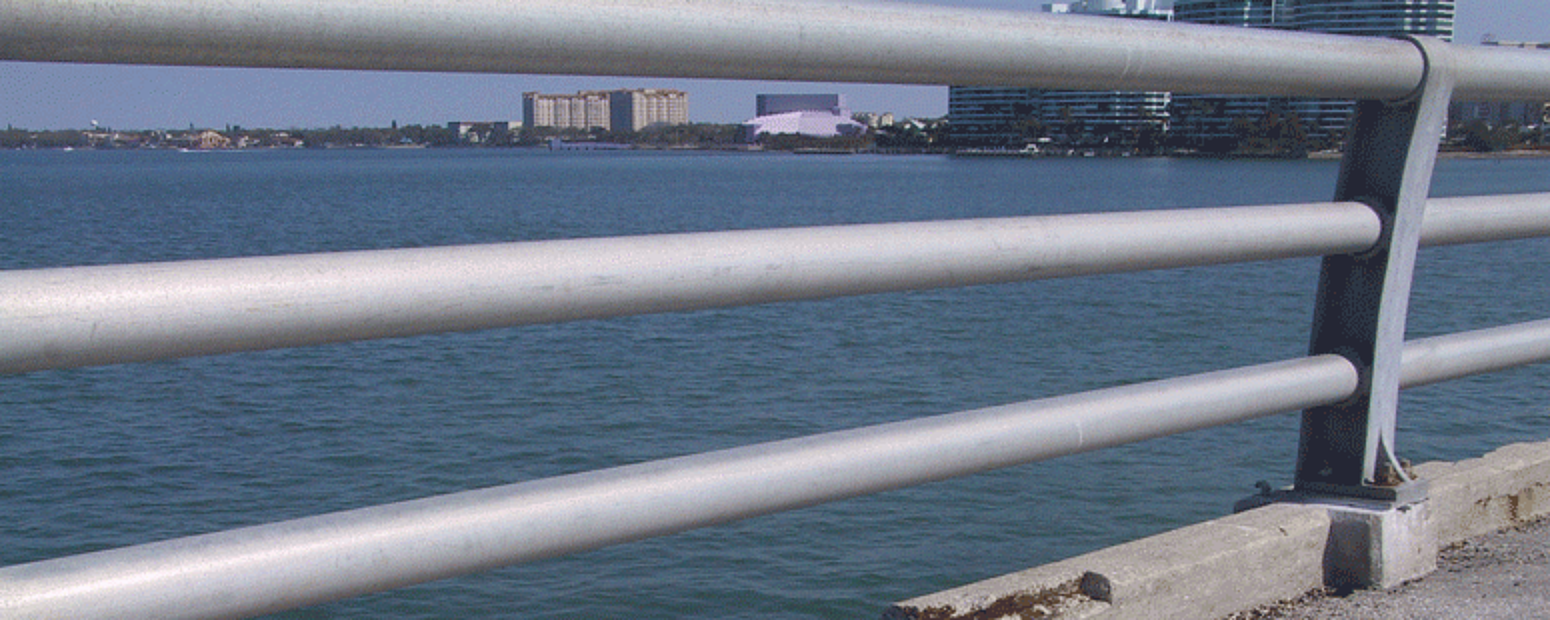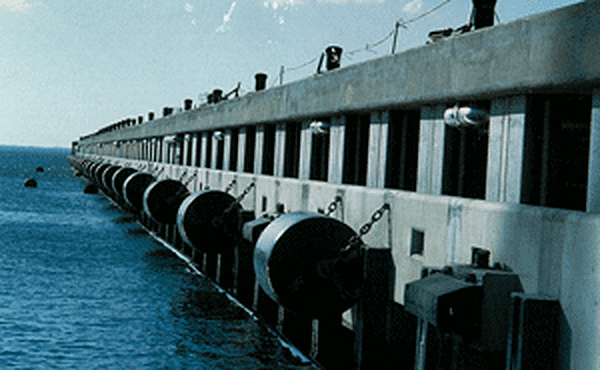In Water

A less common environment for galvanized steel is submerged in or exposed to water. Moisture is highly corrosive to most metals including steel and zinc. Despite the difficulty of predicting corrosion, hot-dip galvanizing steel is one of the best methods of corrosion protection for submersed applications because of its complete, uniform coverage. Similar to the zinc patina in atmospheric exposure, some waters allow the zinc coating to develop a passive film on the surface slowing the corrosion rate.
Similar to soils, the varieties of water make predicting corrosion rates difficult. Many parameters affect corrosion of metals in a water environment, including pH level, oxygen content, water temperature, agitation, the presence of inhibitors, and tide conditions. The first step in deciding whether galvanized steel is the right coating for your application is to determine what type of water will be used. Water can be divided into a number of different types; pure water (e.g., distilled water or de-ionized water), natural freshwater, seawater, or potable water (treated drinking water)and each has different mechanisms that determine the ultimate corrosion rate.
AGA has a detailed guide on the performance of HDG in water environments:
Pure Water
Pure water, also known as de-ionized or distilled water, is usually very corrosive to zinc coatings due to the presence of dissolved oxygen and carbon dioxide. Corrosion rates of steel increase with aeration of pure water; dissolved oxygen in pure water is five to ten times more aggressive than carbonic acid
Natural Fresh Water
Galvanizing is successfully used to protect steel in freshwater exposure. Freshwater refers to all forms of water except sea water. Freshwater may be classified according to its origin or application. Included are hot and cold domestic, industrial, river, lake and canal waters. Corrosion of zinc in fresh water is a complex process controlled largely by impurities in the water. Even rain water contains oxygen, nitrogen, carbon dioxide and other dissolved gases, in addition to dust and smoke particles.
Groundwater carries micro-organisms, eroded soil, decaying vegetation, dissolved salts of calcium, magnesium, iron, and manganese, and suspended colloidal matter. All of these substances and other factors such as pH, temperature, and motion affect the structure and composition of the corrosion products formed on the exposed zinc surface.
Relatively small differences in freshwater content or conditions can produce relatively substantial changes in corrosion products and rate. Thus, there is no simple rule governing the corrosion rate of zinc in fresh water. However, one trend data supports is hard water is much less corrosive than soft water. Under conditions of moderate or high water hardness, a natural scale of insoluble salts tends to form on the galvanized surface. These combine with zinc to form a protective barrier of calcium carbonate and basic zinc carbonate which slow the corrosion rate.
The biggest factors in the zinc corrosion rate in fresh water are dissolved gasses, hardness/mineral rate, flow rate, and other ions/chlorides.
- Gasses: More oxygen means more corrosion products on the surface of the zinc which increases the corrosion rate. For this reason, fully immersed in the water is better than partial immersion because there is less oxygen under water. Well waters tend to have a lower content of dissolved oxygen, so corrosion is low, while surface waters and springs have higher rates.
- Hardness: In hard water, zinc combines with carbonates and bio carbonates to form zinc carbonate, which unlike zinc oxide, is not water soluble. The zinc carbonate deposits on the surface of the zinc and creates a passive film on the galvanized part slowing corrosion. The softer the water, the lower it is in carbonate; therefore, soft water is more corrosive than hard.
- Flow Rate: Higher flow rates tend to increase corrosion because it acts similar to wind in atmospheric exposure it means increased abrasion.
- Other Ions: Chloride is the most aggressive ion to zinc, namely when over 50 mg/L. This tends to be more pronounced in soft waters which often have carbonate levels below 80 mg/L, whereas hard waters have 700 mg/L. The protective film deposited by carbonate in hard water protects the zinc coating from anion attack.
Seawater
Galvanized coatings provide considerable protection to steel immersed in seawater and exposed to salt spray. The factors that influence the corrosion of zinc in fresh water also apply to sea water. However, the biggest determinants to galvanized steels performance in seawater are temperature and ion interaction.

- Temperature: Seawater temperature varies widely from 28.4 F at the poles to 95 F near the equator. For all waters, the warmer the water, the higher the attack on zinc because reactions between oxygen and zinc happen faster at higher temperatures. This is why tropical seawater is much more corrosive than temperate seawater. Temperate seawaters have a freeze cycle and are often less corrosive to galvanized steel than even fresh soft waters.
- Ion Interaction: In moderate temperature ranges zinc forms salts with magnesium and calcium that are not water soluble. These passive compounds form on the surface preventing the zinc metal from reacting with oxygen and chlorides which slows the corrosion rate. Tropical waters tend to stay at 70 or above, making it difficult to develop these compounds, as the colder the temperature the better the formation.
Given the high level of chloride in sea water, a very high rate of zinc corrosion might be expected. However, the presence of magnesium and calcium ions in seawater has a strong inhibiting effect on zinc corrosion in this type of environment. Results from accelerated laboratory tests sometimes use a simple sodium chloride (NaCl) solution to simulate the effects of seawater exposure on galvanized steel and should be viewed skeptically. Real world results often differ significantly from accelerated laboratory tests.
Potable Water
In the mid-1980s Congress passed the Clean Water Act, which includes the Drinking Water Standard. This standard requires that any material or coating that comes in contact with drinking water must be tested. The EPA contracted the National Sanitation Foundation (NSF) to write the test procedure, which after many drafts and public meetings, was finally published as NSF Standard 61: Drinking Water Systems Components: Health Effects. Therefore, only galvanizers that have submitted test coupons of their galvanized steel and have been approved by the NSF have the authority to galvanize steel for use with potable water. Despite the great lengths that a galvanizer must endure to gain this certification, hot-dip galvanized steel is a very suitable application for potable water.
Tidal Zones & Water Agitation
One of the most corrosive areas for galvanized steel is on wash zones and tide lines. The agitation accelerates the corrosion rate of the zinc. Often the washing motion removes the passive scales which are forming on the surfaces, exposing fresh zinc which tries to redevelop more scales/patina. This leads to rapid erosion of the zinc coating resulting in increased corrosion rates.
